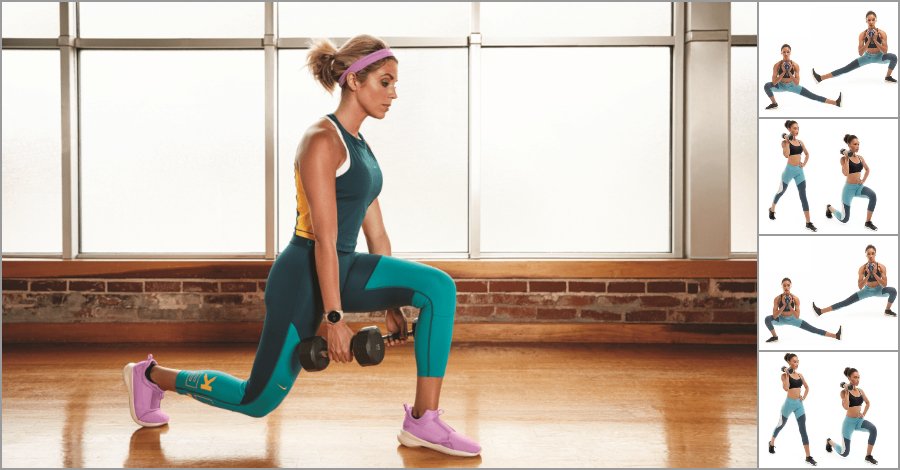Lunges are right up there with squats on the list of Best Exercises You Can Do. Not only does the lunge work your entire lower body and core, but it’s also super functional—which is just a fancy way of saying that it helps you do everyday movements comfortably.
You can do lunges with just your body weight, or you can easily make lunges more challenging by adding free weights like dumbbells, kettlebells, a barbell, or resistance bands. The lunge is also a unilateral exercise, meaning you primarily train one side of your body at a time.
This makes the lunge a great exercise for identifying and correcting any muscle imbalances you have between your left and right side. It also challenges your stability, making it a great sneaky core workout.
As far as lower-body exercises go, lunges are one of the best for developing strength, building endurance and improving balance. But truth: They are also exceedingly boring. Use these four exercises to level up your lunges — and still keep a level head.
Unilaterally Loaded Split Squat:
The split squat helps develop balance and control while maintaining proper hip, knee and ankle position. Unlike a true lunge, your base in a split squat doesn’t move, keeping the tension on your glutes and quads and preventing you from using momentum. Here, you’re loading just one side to challenge your core and hip stability.

How to:
- Hold a dumbbell in your right hand at shoulder height with your chest lifted and elbow down, and stand with your feet in a split stance, left leg forward, right leg back and up on your toes.
- Keep your torso erect as you bend both knees and drop straight down toward the floor until both legs form 90-degree angles at the hips and knees.
- Extend your legs to return to the start. Complete all reps on one side before switching.
- For this move, first, try holding a weight on the same side as your back leg, then try loading on the opposite side (front leg) and see how it increases the instability and makes the move that much harder.
Around The World Lunge:
Multi-planar lunges like this train your muscles to control movement patterns in every direction. Do this version with a light pair of dumbbells for endurance or with bodyweight only as a dynamic warm-up for a heavy leg day.

How to:
- Stand with your feet hip-width apart and your arms at your sides or clasped in front of you.
- Take a large step forward and bend both knees to drop straight down toward the floor, keeping your front knee over your toes and stacked directly on top of your ankle.
- Push off your front foot and return to the center, then step to the side, kicking your glutes back while keeping your torso erect.
- Return to center and then take a step backward and bend both knees to lower into a reverse lunge.
- Return to standing to complete one rep.
- To emphasize your glutes and deep hip rotators, perform the reverse lunge as a curtsy instead:
- Step behind and across the stationary leg while keeping your hips level and maintaining knee and ankle alignment.
Cossack Squat:
This move requires flexibility and control in the end range and can help you train for depth in a squat or for stability at the catch position of a clean or snatch. Holding a weight at chest height counterbalances your hips to prevent you from falling backward if your ankle flexibility and core stability aren’t quite there yet.

How to:
- Hold a dumbbell or kettlebell with both hands at your chest, elbows down, and stand with your feet double shoulder-width apart and turned out 45 degrees.
- Bend your right knee to lunge to the right, dropping your hips down as low as you can while keeping your chest lifted.
- Your opposite leg should stay straight with your foot either flat or flexed.
- Staying low, shift your weight over to the left side so your left knee is bent and your right leg is straight.
- Continue, alternating sides with control.
Lunge Jack:
With the addition of a plyometric element, a regular lunge is transformed into this metabolic booster. Here, you’ll hammer one leg at a time, with just a small reprieve as you jump briefly to the center.

How to:
- Assume a wide split stance and bend both knees to lower into a lunge.
- Your knees and hips should make 90-degree angles with your torso directly over your back knee and your rear foot balanced on your toes.
- Hold here for a count of two, then push off both feet and jump into the air, quickly bringing your feet underneath you and landing gently and quietly on your toes with your knees and hips soft.
- Immediately jump back out into the lunge and hold again for a count of two.
- Perform all reps on one side before switching.

